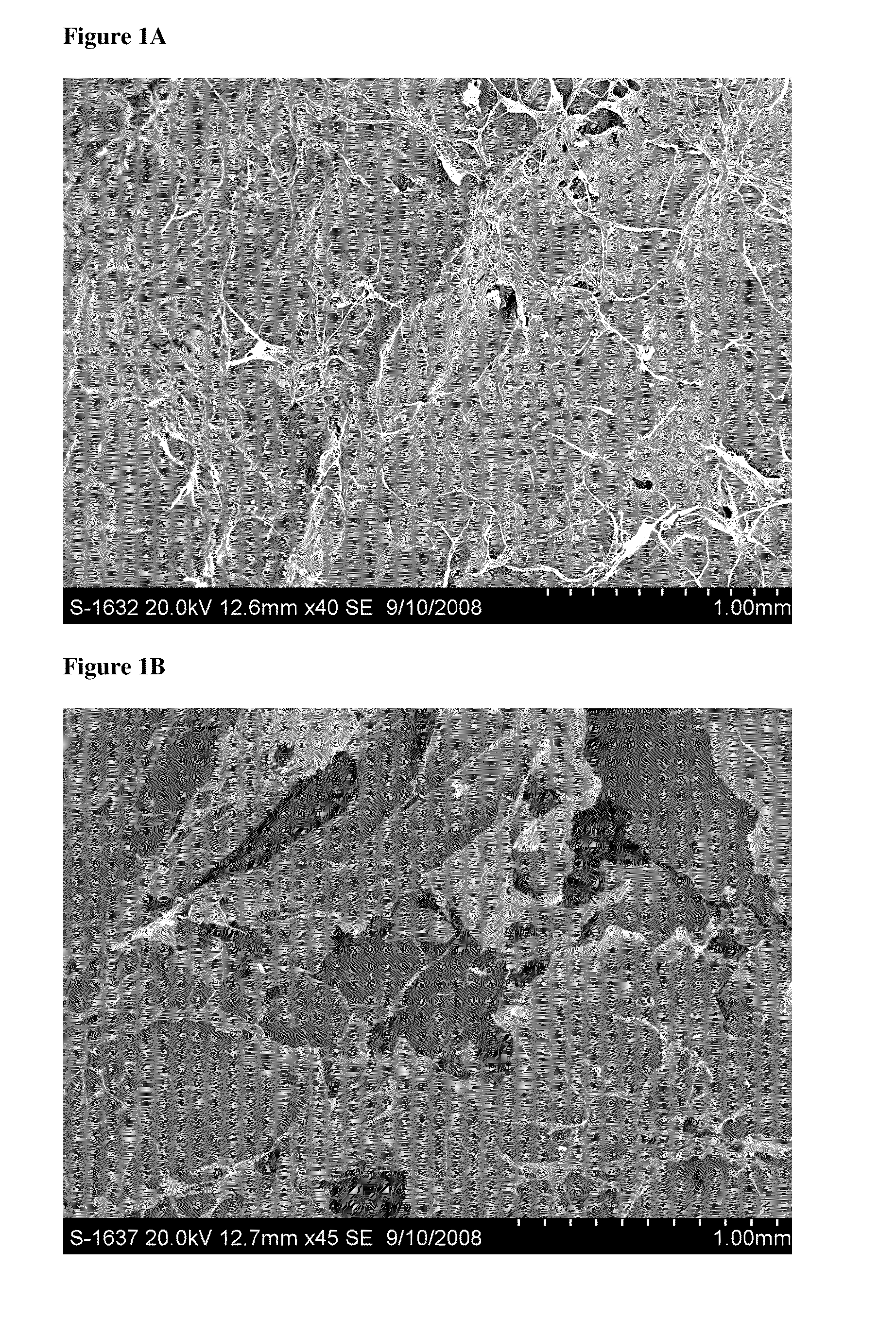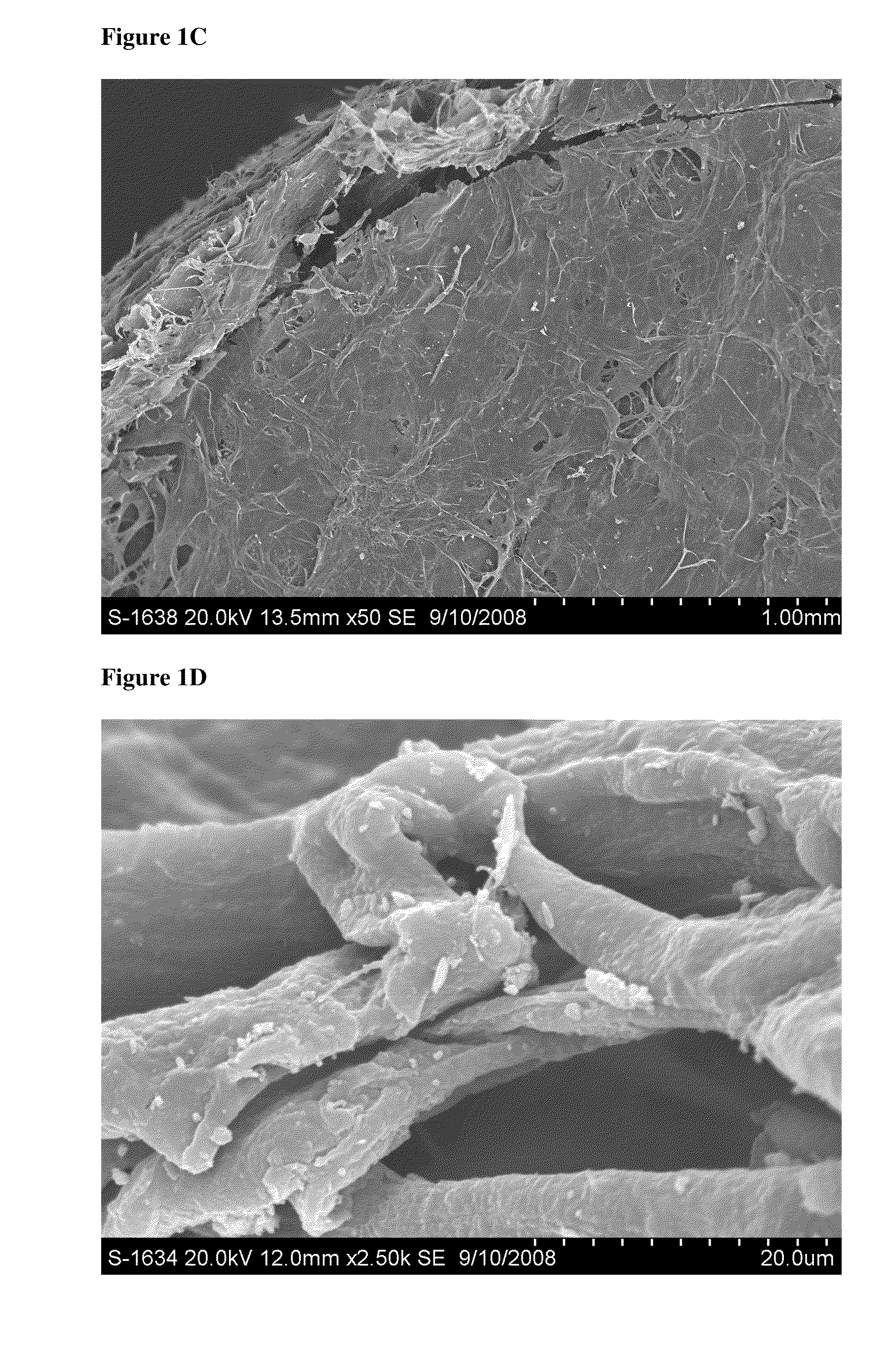Platelet-derived growth factor compositions and methods for the treatment of osteochondral defects
a growth factor and platelet-derived technology, applied in the field of platelet-derived growth factor compositions and methods for the treatment of osteochondral defects, can solve the problems of increasing the recognition of pain and functional problems in patients, limited repair capabilities of cartilage in general, and very difficult healing of injury or trauma to articular cartilage, etc., to and increase cell number or cell growth
- Summary
- Abstract
- Description
- Claims
- Application Information
AI Technical Summary
Benefits of technology
Problems solved by technology
Method used
Image
Examples
example 1
Evaluation of the Physical Characteristics of a Biphasic Plug for Application in Treatment of Osteochondral Defects
[0179]This study evaluated the surface topography, composition, and visualized porosity of a biphasic plug material from Orthomimetic's Chondromimetic using scanning electron microscopy.
[0180]In preparation, the plug (8.5 mm×8 mm) was placed in liquid nitrogen and vertically sectioned in two. The plug was placed in LN2 to maintain the structural integrity of the plug.
[0181]Once halved, the plug was then mounted with double sided adhesive tape to a 26 mm round sample mounting stub. The stub was then placed into the sputter coating apparatus. The sputter coating process bombards the sample to ensure thorough coating with gold particles to increase the electrical conductivity of the sample. Once the sputter coating process was completed, the sample was then ‘grounded’ with graphite glue to discourage charging when viewed in the electron microscope.
[0182]The samples were th...
example 2
Handling Characteristics of a Biphasic Plug
[0183]This study evaluated the handling characteristics of a biphasic plug (Orthomimetic's Chondromimetic Plug), both to evaluate the progress of hydration of the plug material in a buffer solution and to determine the effects of prolonged saturation of the plug material with elution buffer over time. Methylene Blue dye was used as a visual aid to document the hydration of the plug material.
[0184]For both the hydration and saturation study components, initial observations were noted, including: size (upper and lower phase), weight, texture, rigidity, and photographically.
[0185]For the hydration component of the study, a P200 pipette was used to add Methylene Blue dyed sodium acetate buffer to the plug material in increments of 50 μL. Aqueous Methylene Blue solution was made in 20 μl Methylene Blue and 5 mL sodium acetate buffer to make 1% x / v (volume / volume) Methylene Blue. Sodium acetate buffer (20 mM sodium acetate, pH 5.99) was made with...
example 3
[0192]Evaluation of the Release of rhPDGF-BB (Recombinant Human Platelet-Derived Growth Factor-BB) from a Biphasic Plug Material
[0193]This study evaluated the kinetics of rhPDGF-BB release from a biphasic matrix plug (Chondromimetic (Orthomimetics)) over time.
[0194]In sterile conditions, each plug was stabilized over a Sarstedt 15 ml conical polypropylene tube with a 27G½″ needle and syringe (plunger removed from syringe). Each of Orthomimetic's Chondromimetic matrix plug (×3; 8.5 mm×8 mm) was loaded with 450 μL rhPDGF-BB (e.g., 0.3 mg / ml or 1.0 mg / ml), and then allowed to sit at room temperature saturated within conical tube for ten minutes (see FIG. 3).
[0195]Following incubation, 9 ml elution buffer (1% L-glutamine, 1% Pen-Strep, 2% FBS (heat inactivated, Gamma-irradiated), 2.5% HEPES) was placed into 15 ml conical tubes, numbered 1-6. Conical tubes numbered 1-3 contained loaded sample plugs, tubes numbered 4-6 served as controls, where 450 μL rhPDGF-BB was added directly to the e...
PUM
| Property | Measurement | Unit |
|---|---|---|
| concentration | aaaaa | aaaaa |
| concentration | aaaaa | aaaaa |
| weight | aaaaa | aaaaa |
Abstract
Description
Claims
Application Information
 Login to View More
Login to View More - R&D
- Intellectual Property
- Life Sciences
- Materials
- Tech Scout
- Unparalleled Data Quality
- Higher Quality Content
- 60% Fewer Hallucinations
Browse by: Latest US Patents, China's latest patents, Technical Efficacy Thesaurus, Application Domain, Technology Topic, Popular Technical Reports.
© 2025 PatSnap. All rights reserved.Legal|Privacy policy|Modern Slavery Act Transparency Statement|Sitemap|About US| Contact US: help@patsnap.com



